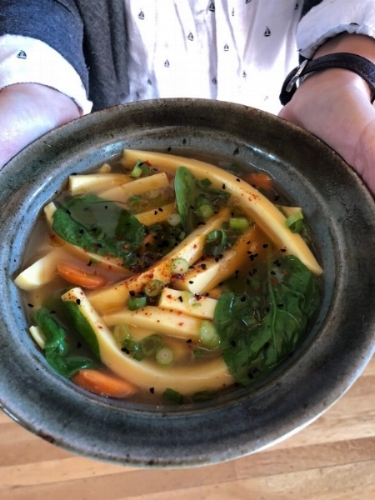This soup also is a preview of a simple legume ferment from our upcoming book on fermented legumes and grains. We are super excited to announce that is what we have been working on all year (much of why you haven’t heard much from us.) Just this week it is out there in the big world with a beautiful cover and ready for pre-order. In it we have taken the mystery out of some of the world’s most delicious and unique ferments—including koji, miso, natto, and tempeh—making them easy with step-by-step instructions.
We hope you enjoy the recipe and the soup warms you up.
Cheers,
Kirsten and Christopher
Myanmar-Style Shan Soup
Yield: 4 good-sized bowls of porridge
Fermentation: 12 hours for the first ferment and 3 hours for the second
Gluten-free, vegan
During our trip to Myanmar, we had planned to visit the region in the northern part of the country where tea leaves are fermented, which is home to many different ethnic groups, several with their own standing armies. We had to change our plans at the last minute because fighting broke out between Myanmar’s government army and one of those regional armies, cutting off our access to the tea villages. We found tea plantations and the fermentation we were seeking, including this tofu, in other parts of the country.
In Burmese, this soup is called hto-hpu new, which either means warm tofu or hot tofu. We got various translations and, depending upon where we were eating it and which hot chile had been added, it did range from warm to very hot. This is a great base for some interesting soup bowls.
8 cups water
2 cups chickpea/garbanzo flour
1 tablespoon peanut oil
1 teaspoon salt
½ teaspoon powdered turmeric
Hot sauce (optional), for topping.
Chopped cilantro, cooked rice noodles, chopped roasted peanuts, blanched greens, or finely sliced shallots (optional), for topping
1. Pour the water into a large bowl. Add the chickpea flour and whisk until well combined. Cover the bowl with a plate or lid and let ferment at room temperature for 12 hours.
2. Stretch a piece of cheesecloth across another large bowl and secure with a rubber band. Pour the chickpea batter through the cheesecloth into the bowl. This may take a little time and patience. It helps to have a rubber spatula handy to periodically scrape the the cheesecloth to remove the chickpea sediment. Compost the chickpea sediment. Cover the bowl of broth and let ferment for 3 hours at room temperature.
3. Pour the oil into a heavy pot and rub it around to coat the bottom and sides. Stir the chickpea broth and pour all of it into the pot. Stir in the salt and turmeric.
4. Bring the mixture to a boil over high heat, then reduce the heat to medium-low and cook at a slow boil until thickened and slightly reduced, 20 to 25 minutes. Stir continuously with a spatula to keep the mixture from sticking to the bottom of the pot.
5. Remove the pot from the heat and serve the soup immediately, topped with a drizzle of hot sauce, if you like, and your favorite fresh toppings.


